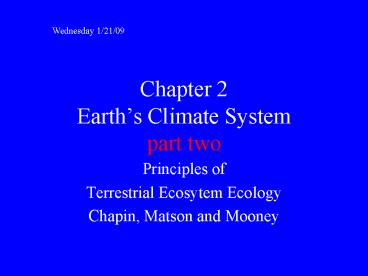Chapter 2 Earths Climate System part two - PowerPoint PPT Presentation
1 / 35
Title:
Chapter 2 Earths Climate System part two
Description:
Let's see if we can crash-test the clicker system in this room: ... Water cools the tropics, cools tropical and. temperate zone coastal areas, and warms north ... – PowerPoint PPT presentation
Number of Views:40
Avg rating:3.0/5.0
Title: Chapter 2 Earths Climate System part two
1
Chapter 2Earths Climate Systempart two
Wednesday 1/21/09
- Principles of
- Terrestrial Ecosytem Ecology
- Chapin, Matson and Mooney
2
- Lets see if we can crash-test the clicker system
in this room - The amount of energy from the sun, collected at
the outer - space boundary, over a square meter for an
hour, - is about equal to
- A gallon of gas
- a half gallon of gas
- About a dozen (12), 300 calorie power bars
- About four, 300 calorie power bars
(short answer question how far can you drive
your car using an hours worth of the solar
constant collected over 1m2?
3
- 2. The amount of solar energy that exits
- our atmosphere unused is about
- 50 of what comes in
- 40 of what comes in
- 30 of what comes in
- 20 of what comes in
- 10 of what comes in
4
(No Transcript)
5
- The first way that ecosystems participate
(interact, - provide feedbacks) with the earths system
is by - influencing reflectivity.
- a) albedo of the surface (canopy).
- b) effect of that surface on cloud
formation - (which also affects albedo).
- Hypothesis ecosystems provide an ecosystem
- service climate control AND energy capture
- by maximizing energy capture while
minimizing - undesirable heating?
6
- (In terms of perpendicular energy capture)
- The highest absorbance of solar energy
- is observed for ________ and the best reflector
- (highest albedo) material is _____________.
- Green vegetation, sand
- water, snow
- Sand, dark soil
- Coniferous forest, sand
7
Life in the Anthropocene may start out like
the medieval anomaly
Fig. 2.12
8
(No Transcript)
9
The change in planetary albedo may explain, in
part, the transition from ice age to a warmer
system.
10
After Albedo effects the climate, and after the
partioning Of captured energy into latent vs
sensible heating, the ecosystem effects on the
greenhouse gases become another dimension
11
the presence of water vapor and CO2 in the
atmosphere creates a significant (current)
greenhouse effect Without these gases Earths
temperature would be about 33oC cooler, and the
planet would be covered in ice. (from
Schlesingers Biogeochemistry text)
12
Atmospheric Carbon Dioxide at Niwot Ridge Colorado
- 1980
1990 2000
13
Figure SPM.2
14
Fig 2.2
15
Is it possible to reduce energy capture and
reduce heating at the same time? Ironicallyit
is possible to reduce total solar energy
capture AND increase heating.
16
The Balance
17
What happens when we expose 1 cal/cm2/min of
shortwave on
Vegetated surface
water
Dry surface
18
Intermediate High latent heat IF.
Energy/climate review
Less energy absorbed High albedo? Huge
longwave return
More energy absorbed Low albedo High latent heat
Vegetated surface
water
Dry surface
latent heat (evap)
Longwavesensible
19
Both the presence and absence of vegetation, as
well as the type of vegetation, affect local and
regional climates!
Fig. 2.11
20
The Balance
21
Ecosystems structured on seasonality and amounts
of energy and precipitation.ZZZZZZZ
22
How to dilute sunlight
Text, fig 2.5
23
Water cools the tropics, cools tropical and
temperate zone coastal areas, and warms
north temperate, boreal and polar regions.
solar
longwave
south pole equator
north pole
24
the unequal input of energy from the sun is
mediated, somewhat, by ocean and atmospheric
currents that pump this energy towards the
poles. Water both increases the amount of
energy captured by the planet (lower
albedo)but also reduces temperature extremes
associated with energy exchange because of the
thermal capacity of water
25
Water cools the tropics, cools tropical and
temperate zone coastal areas, and warms
north temperate, boreal and polar regions.
solar
longwave
south pole equator
north pole
26
(No Transcript)
27
Heat transfer via oceanic currents are important
in explaining global patterns of climate. we
will not include these in our analysis of
terrestrial ecosystems.except to note the
importance of the equator-to-poles energy pump.
28
Adjacent cells rotate in opposite directions
(think wheel cogs or clock gears)
0 - highest ppt 30 - low ppt 60 -higher
ppt 90 - low ppt
29
Fig. 2.6
30
Why asymmetric
31
Climate control of ecosystems First level of
resolution Solar energy, as influenced by
available water, produces a fixed amount of
plant production. This is the green slime
modelwhat are the assumptions? Second level of
resolution Solar energy, as influenced by
available water, produces a predictable ecosystem
structure.
32
nose graph
Missing Cold, wet ecosystems?
Fig. 2.22
33
The competitions nose graphwhat happens when
we hold precipitation constant?
34
Ignoring human manipulations, it is often
possible to predict the type(s) of communities
we should expect based upon annual temperatures
(often a surrogate for energy) and
precipitation. However, we need to know
something about the seasonality of both
temperature and precipitation to make educated
guesses. And comparisons of Australian
ecosystems with similar ones separated by 50
million years of evolution shows how much
influence evolution can have on these systems.
35
An expanded nose graph Average temp and
moisture doesnt produce clean patterns.
zzzzzzzz































